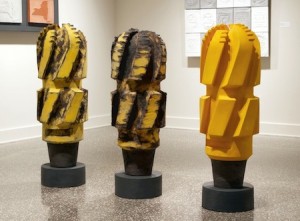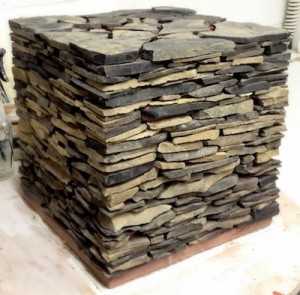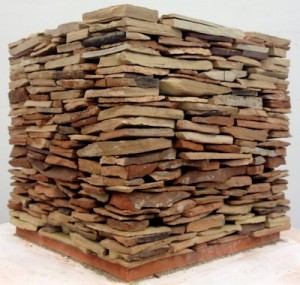
 In Booras’ Formation, Fault, Fracture, each of the three bits represents a different stage in the service life of the implement. “They are displayed as both monuments and artifacts, providing witness to the infrastructures of our industrialized society,” he said in his thesis. Credit: G. Booras.
In Booras’ Formation, Fault, Fracture, each of the three bits represents a different stage in the service life of the implement. “They are displayed as both monuments and artifacts, providing witness to the infrastructures of our industrialized society,” he said in his thesis. Credit: G. Booras.
We recently wrote about fracking technology and its enormous potential to help meet domestic energy needs by unlocking massive supplies of methane from shale formations across the US. Some see the technology as a path to energy independence, others as a road to environmental ruin.
Ceramic artist Geoffrey Booras acknowledges this fundamental conflict and uses it in work inspired by fracking technology and a scientific background. Trained as a geologist, he is currently pursuing a master’s degree in fine arts from the State University of New York at New Paltz.
Booras’ latest work was inspired by exposed portions of the massive Marcellus shale formation in the New Paltz area, and in particular by the diamond drill bits and other technology used to drill the horizontal wells used in fracking. Some of it will be on exhibit in the Boston, Mass., area until July 21.
“I believe that technology alters and shapes the way that nature is interpreted by humans,” Booras wrote in his master’s thesis. “Through geologic explorations I seek to better define our enmeshed relationship with nature. For this, I construct works concerned with oil and gas exploration and its underlying infrastructure.”
In addition to the drill bits, he also has done other work inspired by fracking. An example is One Cubic Foot, which is exactly what it sounds like—a cubic foot of Marcellus shale, held together with glaze and fired to fuse the layers of rock.
Because natural gas production is measured in cubic feet, Booras created One Cubic Foot. Photos show the unfired, raw cube of Marcellus shale (top) and the cube after firing to cone 04 (1,915ºF). The artist used glaze as mortar to fuse the piece and noted that firing also renders the composition devoid of hydrocarbons. Credit: G. Booras.
Training as a geologist has given Booras a unique perspective on exploitation of shale gas as well as on the impact humans have on Earth in general. He is among geologists who believe we are living in a new geologic epoch—the Anthropocene. This era covers the past 10,000 years or so, when humans began leaving their mark upon the Earth. “Anthropocene (is) a newly defined geologic era (essentially to replace Holocene) in which the period of human impact on the lithosphere is the definitive characteristic,” Booras wrote on his website.
According to the artist, his work combines art and science in a way that allows him to create pieces with a unique perspective and resolve his personal conflict between environmentalists on one hand and the oil industry on the other. “Harnessing the Anthropocene is my way of dealing with these conflicts,” he wrote in his thesis.
At New Paltz, Booras has experimented with Marcellus shale as a material for his art, including milling it into a workable slip. “I transform this resource. My use of Marcellus shale also stands as a concept—comparing ecological ruination with the benefits of a modern petroleum-based world,” he wrote on his website.
“By reinterpreting objects in clay, mechanical implements such as massive drill bits designed for mining petrochemicals, become fragile and hollow. These monuments of engineering double as a testament of technological progress as well as the comprehension of the possibility of our own destruction, in the jaws of our own creation…I am creating my own fossil record from artifacts and impressions of human activity.”


